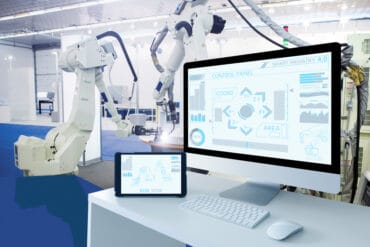
As the factory environment continues to evolve beyond this pandemic, AR-enabled programs will deliver transformational results to manufacturers and industrial enterprises.
When augmented reality (AR) was first introduced in 1992, the primary use cases for the technology involved military or gaming applications. Nearly 30 years later, many enterprises in the industrial sector are turning to AR technology to aid in the remote training, and up-skilling and re-skilling of their workforces and are reaping the benefits.
Workforce Shortages in Manufacturing
Over the past five years, manufacturers have reported a growing shortage of qualified skilled laborers. These include positions such as machine technicians and worksite managers. The workers filling these jobs must not only be able to efficiently perform difficult and stressful tasks onsite, but also meet safety requirements as they are mandated by OSHA and other regulatory agencies.
See also: Augmented Reality is ‘IoT for People’
In September 2019, the National Association of Manufacturers claimed that 522,000 job posts went unfilled – a record number. The lack of unskilled laborers will only worsen, as The Manufacturing Institute anticipates 2.4 million unfilled jobs over the next decade. The U.S. administration has recognized the need for additional skilled industrial workers and has committed to training 1.86 million workers in the next five years. However, mid-size and regional manufacturers need to increase the size of their workforce now, not in five years.
To lessen the skills gap in the years ahead, new hires will need to be rapidly trained on the machinery and processes they will be overseeing, as manufacturers aim to resume full-scale operations immediately and take advantage of their full workforce. In addition, returning workers will potentially need to be trained to manage new digitized and automated technologies that they didn’t interact with prior to the pandemic.
Using Augmented Reality to Train Workers
This rapidly changing labor landscape is forcing the industrial sector to implement AR technology. AR enables manufacturers to digitize their workforce training programs – allowing them to train their employees faster and more efficiently than would otherwise be possible.
New workers in the manufacturing industry that need to train to learn new and different equipment can leverage heads up displays to follow along with an experienced trainer. For example, a new worker can learn different or new manufacturing processes via an AR headset. Trainees can follow step by step instructions for any necessary job functions with the headset overlaying the processes with the manufacturing equipment and real-world environment. This allows them to see how to apply the instructions to the correct parts of the machinery in real-time.
The standardization of training programs through digitization also ensures each worker receives the exact same level of training. Further, manufacturers will not have to be concerned with accidental miseducation of trainees that could be caused by an instructor oversight – such as forgetting to mention a small but important piece of the training. When dealing with heavy equipment and machinery found in manufacturing shop floors, missing even the smallest training detail can result in a workplace safety issue.
Using AR During COVID-19
In response to COVID-19 and the associated stay-at-home mandates, many manufacturers have been forced to send the majority of their floor workers home. Many of these manufacturers cannot continue production without onsite personnel to carry out day-to-day operations. On the other hand, they cannot violate mandates regarding social distancing and non-essential business closures.
The COVID-19 pandemic has also forced non-essential manufacturers to shut down operations. At the same time, the need for PPE, ventilators, and masks skyrocketed as coronavirus infections rapidly spread at the start of the pandemic. Non-essential manufacturers who have been forced to shut down their facilities to comply now can become an essential business by pivoting operations to support the manufacturing of these necessary items. AR technology enables manufacturers to rapidly shift operations by quickly re-skilling and up-skilling their workforce to produce these much-needed items, while also ensuring they maintain the high standards required of the products.
In order to remain operational and maintain remote worker productivity, an increasing number of manufacturers are implementing AR-enabled remote assistance solutions. AR-enabled remote assistance allows detailed interactions between onsite personnel and offsite experts to take place. In many situations, a simple phone call might suffice to diffuse any onsite issues or troublesome situations. However, this is not always the case.
By combining AR applications with a live video feed of the onsite worker’s situation and environment, a remote expert or technician with superior knowledge can observe situations in real-time and provide specific, detailed instructions on how to perform the task at hand. Further, because AR uses video-based interactions, the onsite worker has no trouble understanding the expert’s advice because it will be demonstrated, virtually, right before their eyes.
3D spatial notations on touchscreen devices can be layered over real-time video feeds to highlight which specific machine or application components require servicing or attention. For example, say a worker has trouble with a machine overheating on the shop floor. If they are new to the role, they may have no experience whatsoever with that machine and how it functions. Thanks to AR, the offsite expert can not only explain but also show exactly what the new worker must do to fix the machine.
AR technology enables the rapid training of the manufacturing workforce, as well as the detailed communication between onsite technicians and offsite experts. These efficient, modernized, and digitized training programs will enable manufacturers to enhance the shift to flexible production models. As the factory environment continues to evolve beyond this pandemic due to technological, social, and regulatory changes, AR-enabled programs will continue to deliver transformational results to manufacturers and industrial enterprises.




























